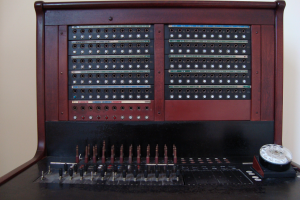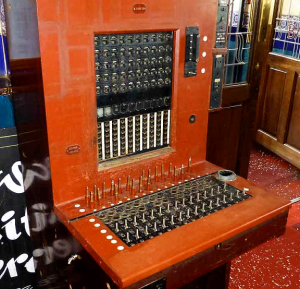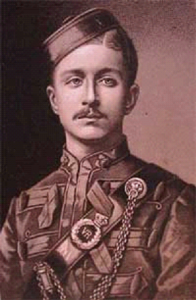Background
On some diecast models of BBC Vehicles, the BBC phone number was WELbeck 4468 – which became LANgham 4468. The BBC Television Centre phone number was SHEpherds Bush 8000
(see BBC Vehicles Diecast Models)
Bill Jenkin
The SHEpherd’s Bush (743) 8000 number still works, only it’s 0208 743 8000 now of course. Which is interesting as the TV Centre has now closed.
Also the LANgham number still works, 0207 580 4468.
Of course both will put you through to a call centre somewhere in the back of beyond.
Mike Jordan
A technical man should know that nowadays the correct way to group numbers is
020 8743 8000 and
020 7580 4468.
To allow for sorting things for overseas callers and mobiles etc and (for now at least) when calling from the inside London Director area, the 020 prefix is not needed.
Of course now, due to shortage of numbers, there are now London numbers that don’t tie in with the old 01 inner and outer London groupings!
Sorry – trust an ex BBC BH Comms guy to mention this – one who still has somewhere the original GPO letter/number conversion charts and hypothetical exchange numbers and know where to find the details of how exchanges got their names!
Patrick Heigham
Yes, indeed.
I was membership secretary for The Association of Motion Picture Sound, with which I got involved on switching from TV to Films.
When the phone codes changed, our database of members had to follow the correct number display! (include the 7 or 8 if dialling to/from either of the other sectors).
I remember Scotland Yard being WHItehall 1212 ?
Alasdair Lawrance
Being of a certain age, I still write phone numbers the old fashioned way. It makes them much easier to remember, and I can tell, roughly, if they’re ‘inner’ or ‘outer’ London, by the 0207 or 0208.
Dave Buckley
This website is worth a look…
http://www.rhaworth.myby.co.uk/phreak/tenp_01.htm
The comment on the site below the table reads…. "DREadnought and FREmantle both map on to 373. Both names were published – why? Likewise DUKe and FULham."… This leaves out LEYtonstone and KEYstone which were also the same holes in the dial.
Patrick Heigham
Speaking of the dial holes, was it not that 999 was adopted for Emergency, since in total darkness, one could find the right dial number by its proximity to the finger stop (two away – 0 was Operator)?
Alex Thomas, Alasdair Lawrance
I seem to remember that some government buildings had a FEDeral telephone number or prefix 333. I once got the answer " This is Federal 5000 – clear down, please". These days I suppose GCHQ would hang on to see if it was worth listening to.
John Howell, Ian Hillson, Dave Buckley, Dave Plowman
Also FRAnklin, and TROjan: The GPO headquarters was HEA.. Some codes still exist, and were not expunged in 1968/69 when the GPO went to all-numbers and got rid of the Director dial: SKYport for instance, for Heathrow. When the airport was being developed, it was found that it fell outside what was then known as the London Telephone Area (that is, where you dialled the three letters and four numbers irrespective of which exchange you were on, and the exchange did the rest – known as a Director area). In fact the local telephone exchange was Colnbrook. The boundary of the LTA was rapidly changed to take in the airport! Interestingly, other nearby towns such as Uxbridge weren’t brought into the LTA.
Going back the 1948 Olympics, the GPO set up an exchange called CORinthian to cover the Wembley site. I have an idea that this was actually part of the local ARNold exchange as after the Games were over a batch of ARNold 7xxx numbers became available, one of which my parents got.
A previous posting pointed out that not all exchange codes changed when dropping letters for numbers. In the Harrow/Kenton area WORdsworth, HARrow, UNDerhill and BYRon certainly remained the same holes in the dial.
This may have been the case throughout London. The letters were merely changed to the (same) numbers. But number only exchanges were added at the same time, with lots of people creating names for them.
Ian Hillson
The GPO started all-figure dialling in 1966, and by 1968 it had reached Richmond where I live and RIC (742) changed to 940 – a bit later they added 948 too – and in the 1990s they added the code 332 for an electronic exchange with DTMF dialling and all the other bells and whistles. Originally this equipment wasn’t at Richmond at all – it was an overlay on Wimbledon exchange, which was electronic.
Alex Thomas
I can still remember that Newbury Exchange was still manual in the nineteen seventies and the DEL when lifted would be answered by a telephonist saying "Number Please".
Quite a transition from a colour scanner with the latest technology and a telephone exchange that was pre-Strowger.
Tony Crake
As a historical oddity… When I joined the BBC in 1962 I spent 4 years on HF transmitters up in Cumberland (as it then was).
We had two DELs but they had NO conventional numbers. We were "Trunks Subscriber 3 and 4 " If you wanted to ring the stations that is what you asked for and to make an outgoing call you rang on the Control Room EMX Panel!
In fact the attached picture ( taken in a hotel in Majorca!) is very similar… the dial is for the local PABX system.
This was still in use sometime about 2002 (but they have just kept it as an exhibit).
They seem to be British PO Jackplugs
(Click on the picture below to see larger version:
use your Browser’s BACK button to return to this page)
Mike Jordan
PO 316 – as used by BBC in jackfields for years.
Note on that switchboard the real “Kellogg” keys used everywhere. In BH we had a very similar board for routing teleprinters as well but a teleprinter keyboard and punched tape machine instead of a headset!
Barry Bonner
This kit is in Mad O’Rourke’s Pie Factory (a splendid pub) in Dudley, a short walk from the canal.
(Click on the picture below to see larger version:
use your Browser’s BACK button to return to this page)
Albert Barber
I don’t know much about BT or rather Post Office Telephones but I always had the feeling that they always had a close association with the BBC.
Much of the innovation came from these two institutions from Computing to Comms, right up to digital technology.
Peter Hider
I grew up in Chislehurst which is on the London border with Kent. The exchange code was IMP which was shortened from Imperial as Napoleon III and his wife lived there in the middle part of the 19th century when he was exiled from France. There is still a memorial Celtic Cross to his son Louis, The Prince Imperial, on Chislehurst Common as he was killed in 1879 fighting for the British during the Zulu War.
The Prince Imperial, Napoleon IV
(Click on the picture below to see larger version:
use your Browser’s BACK button to return to this page)
His funeral in Chislehurst was almost a State funeral.
His mother the Princess Eugenie continued to live in Chislehurst and then moved to Farnborough in Hampshire where she erected a Mausoleum where both the Emperor and his son are interred. She died in 1920. IMP is still used for the area as 467. A full circle was achieved when my mother worked as a telephonist in the Chislehurst Exchange in the 1950s and 1960s when it was still manual.






